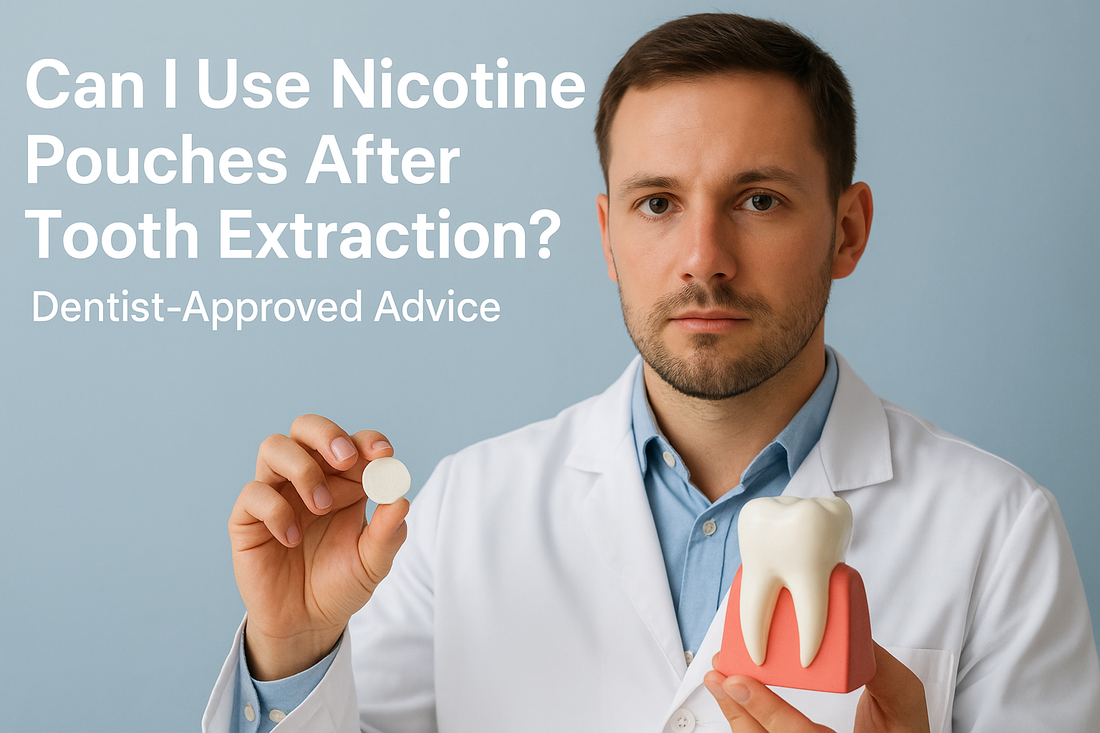
Can I Use Nicotine Pouches After Tooth Extraction? Dentist-Approved Advice
Dental procedures, particularly tooth extractions, require careful consideration of post-operative care to ensure optimal healing and prevent complications. Many patients wonder about continuing their nicotine pouch routine during recovery periods. This comprehensive guide provides dentist-approved advice on using nicotine pouches after dental procedures, covering timing considerations, healing factors, and best practices for maintaining oral health.
Understanding Post-Extraction Healing
After tooth extraction, your mouth undergoes a complex healing process that typically spans several weeks. The initial 24-48 hours are crucial for clot formation and the beginning of tissue repair. During this period, the extraction site is particularly vulnerable to disruption and infection.
The healing timeline generally follows predictable stages: immediate clot formation, initial tissue healing over 3-7 days, and complete healing over 2-6 weeks depending on the complexity of the extraction. Understanding this process helps inform decisions about when activities like using nicotine pouches can be safely resumed.
Blood clot stability is essential for proper healing, as the clot protects the extraction site and provides a foundation for new tissue growth. Any activity that might disturb this clot or interfere with healing should be carefully considered and timed appropriately.
Immediate Post-Extraction Period (First 24-48 Hours)
Can I use nicotine pouches after tooth extraction in the immediate recovery period? Dental professionals typically recommend avoiding nicotine pouches during the first 24-48 hours following extraction. This initial period is critical for clot formation and early healing stages.
The primary concern during this immediate period involves protecting the blood clot that forms in the extraction socket. Any activity that creates suction, pressure changes, or mechanical irritation could potentially dislodge this protective clot, leading to complications such as dry socket.
Nicotine pouches placed near the extraction site could potentially interfere with clot stability through direct contact or the natural oral movements associated with pouch positioning. The safest approach during this critical period is to avoid all non-essential oral activities that might compromise healing.
The 48-72 Hour Transition Period
After the initial 48-hour period, many patients can begin considering the gradual resumption of normal activities, including nicotine pouch use. However, this transition should be approached cautiously and with attention to individual healing progress.
During this period, the extraction site begins developing more stable tissue coverage, but complete healing is still weeks away. Patients should assess their comfort level, pain status, and any signs of complications before resuming nicotine pouch use.
Consulting with your dental provider before resuming nicotine pouches ensures that your specific healing progress supports safe resumption. Individual healing rates vary, and some patients may need longer recovery periods before safely using oral products.
Safe Resumption Guidelines
When resuming nicotine pouch use after tooth extraction, several important guidelines help ensure safe and comfortable experiences while supporting continued healing:
- Placement Considerations: Avoid placing pouches directly adjacent to extraction sites. Choose locations on the opposite side of your mouth or areas that won't contact healing tissue. This positioning prevents direct pressure or irritation to sensitive areas.
- Gentle Handling: Use extra care when placing and removing pouches to avoid creating suction or pressure that might affect healing sites. Gentle movements and patience during placement help prevent accidental contact with extraction areas.
- Timing Awareness: Consider using pouches between meals and oral care routines to minimize the number of times you're manipulating items in your mouth. This coordination reduces overall oral activity and supports healing.
Oral Health Considerations
Do nicotine pouches cause tooth decay? This common concern is particularly relevant during post-extraction healing when maintaining optimal oral health becomes even more important. Quality nicotine pouches, when used properly, don't typically contribute to tooth decay.
Premium pouches like those from Killa and Pablo are formulated to maintain appropriate pH levels that don't promote cavity-causing bacteria. The absence of fermentable sugars in quality formulations means they don't provide the acidic environment that bacteria need to create tooth decay.
However, maintaining excellent oral hygiene becomes even more critical during post-extraction healing. Regular gentle cleaning, appropriate mouth rinses, and following your dentist's specific care instructions help ensure that pouch use doesn't interfere with healing or oral health maintenance.
Healing Optimization Strategies
Supporting optimal healing while using nicotine pouches requires attention to several key factors that influence recovery success:
- Hydration Maintenance: Proper hydration supports healing and helps maintain optimal saliva production, which is important for both healing and comfortable pouch use. Adequate fluid intake benefits both recovery and product effectiveness.
- Nutrition Support: Eating appropriate foods that support healing while avoiding items that might interfere with extraction sites helps optimize recovery. Soft foods and adequate nutrition support the healing process.
- Stress Management: Post-operative stress can affect healing, and maintaining nicotine routines in a safe, appropriate manner may help some patients manage procedure-related anxiety without compromising recovery.
Signs to Watch For
When resuming nicotine pouch use after extraction, monitoring for signs that might indicate problems helps ensure safe continuation:
- Increased Pain: New or worsening pain after resuming pouches might indicate irritation or interference with healing. Discontinuing use and consulting your dentist helps address any concerns promptly.
- Swelling Changes: Increased swelling around extraction sites after resuming pouches could suggest irritation or complications. Professional evaluation helps determine appropriate responses.
- Bleeding Concerns: Any new bleeding from extraction sites after resuming nicotine pouches should be evaluated by your dental provider to rule out complications or healing disruption.
Individual Variation Factors
Healing rates and tolerance for resuming normal activities vary significantly between individuals. Several factors influence when nicotine pouch use can be safely resumed:
- Age and Health Status: Younger patients and those in good health typically heal faster and may be able to resume activities sooner than older patients or those with health conditions that affect healing.
- Extraction Complexity: Simple extractions generally heal faster than complex procedures, influencing when normal activities can be resumed. Surgical extractions may require longer recovery periods before resuming pouch use.
- Individual Healing Response: Some patients heal exceptionally quickly while others need extended recovery periods. Personal healing characteristics should guide timing decisions more than general guidelines.
Professional Guidance Importance
Consulting with your dental provider before resuming nicotine pouch use ensures that your specific situation is properly evaluated. Dental professionals can assess healing progress and provide personalized guidance based on your individual circumstances.
Professional evaluation considers factors that patients might not recognize, such as healing quality, infection signs, or complications that could be affected by resuming nicotine pouch use. This expertise helps ensure safe decision-making.
Regular follow-up appointments allow ongoing assessment of healing progress and adjustment of activity restrictions as recovery progresses. This professional monitoring helps optimize both healing and quality of life during recovery.
Long-Term Oral Health Maintenance
Maintaining excellent oral health while using nicotine pouches requires ongoing attention to hygiene practices and regular dental care. This commitment becomes even more important for patients who have undergone dental procedures.
Regular dental cleanings and examinations help identify any issues early and ensure that nicotine pouch use doesn't interfere with long-term oral health. Professional monitoring provides peace of mind and optimal health outcomes.
Quality pouch selection from reputable manufacturers like Killa and Pablo supports long-term oral health through superior formulations and manufacturing standards that prioritize user safety and comfort.
Special Considerations for Different Procedures
Different types of dental procedures may require varying approaches to resuming nicotine pouch use:
- Simple Extractions: Single tooth extractions typically heal relatively quickly, often allowing pouch resumption within 48-72 hours when placed away from extraction sites.
- Multiple Extractions: Procedures involving multiple teeth may require longer recovery periods and more careful placement considerations to avoid all healing areas.
- Surgical Extractions: Complex procedures like wisdom tooth removal may necessitate extended recovery periods before safely resuming nicotine pouch use.
Optimizing Comfort During Recovery
When resuming nicotine pouch use during dental recovery, several strategies help maximize comfort and support continued healing:
- Strength Considerations: Starting with lower-strength pouches during initial resumption may provide more comfortable experiences while tissues are still healing and potentially more sensitive.
- Duration Modifications: Using pouches for shorter periods initially and gradually returning to normal usage patterns helps ensure comfort and prevents overexertion of healing tissues.
- Temperature Awareness: Room temperature or slightly cool pouches may be more comfortable than those that have been stored in warm conditions, particularly during the sensitive healing period.
Alternative Timing Strategies
For patients who want to maintain nicotine routines during recovery, alternative timing strategies can help balance needs with healing requirements:
- Meal Coordination: Using pouches between meals and oral care routines minimizes total oral activity and supports healing by reducing manipulation frequency.
- Sleep Considerations: Avoiding pouches immediately before sleep during recovery helps prevent unconscious positioning that might affect healing sites.
- Activity Timing: Coordinating pouch use with other daily activities helps create routines that support both nicotine needs and healing requirements.
Quality Product Selection Benefits
Choosing premium nicotine pouches from established manufacturers provides advantages during recovery periods when oral comfort and product reliability become particularly important:
- Consistent Quality: Premium products offer predictable experiences that help avoid surprises or variations that might be uncomfortable during healing periods.
- Superior Materials: High-quality pouch materials and construction provide better comfort and reliability during sensitive recovery periods.
- Appropriate Formulations: Premium products feature balanced formulations that support comfortable use without contributing to oral health concerns.
Balanced Approach to Recovery
Can I use nicotine pouches after tooth extraction? With proper timing, careful placement, and professional guidance, many patients can safely resume nicotine pouch use during dental recovery. The key lies in respecting healing timelines, following professional advice, and prioritizing recovery over convenience.
The safest approach involves waiting 48-72 hours after extraction, consulting with your dental provider, and resuming use gradually with attention to comfort and healing progress. Quality products from reputable manufacturers like Killa and Pablo provide the reliability and comfort that support safe resumption during recovery periods.
Remember that individual healing varies, and professional guidance should always take precedence over general recommendations. By combining patience, professional consultation, and quality product selection, patients can successfully balance their nicotine preferences with optimal dental healing outcomes.

